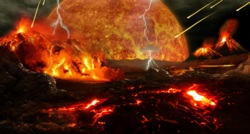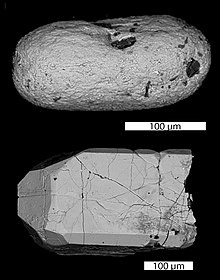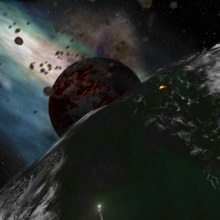|
|
| |
|
|
| |
|
|
|
|
| |
 |
| Artist's impression
of a Hadean landscape. |
Hadean
The Hadean ( /ˈheɪdiən, heɪˈdiːən/ HAY-dee-ən, hay-DEE-ən)
is a geologic eon of the Earth pre-dating the Archean.
It began with the formation of the Earth about 4.6
billion years ago and ended, as defined by the
International Commission on Stratigraphy (ICS), 4
billion years ago. As of 2016, the ICS describes its
status as "informal". Geologist Preston Cloud coined the
term in 1972, originally to label the period before the
earliest-known rocks on Earth. W. Brian Harland later
coined an almost synonymous term, the Priscoan period,
from priscus, the Latin word for 'ancient'. Other, older
texts refer to the eon as the Pre-Archean. |
|
Etymology
"Hadean" (from Hades, the Greek god of the underworld,
and the underworld itself) describes the hellish
conditions then prevailing on Earth: the planet had just
formed and was still very hot owing to its recent
accretion, the abundance of short-lived radioactive
elements, and frequent collisions with other Solar
System bodies. |
|
 |
| Backscatter electron
micrograph of detrital zircons from the Hadean
(4.404 ± 0.008 Ga) metasediments of the Jack
Hills, Narryer Gneiss Terrane, Western
Australia. |
Hadean rocks
In the last decades of the 20th-century geologists
identified a few Hadean rocks from western Greenland,
northwestern Canada, and Western Australia. In 2015,
traces of carbon minerals interpreted as "remains of
biotic life" were found in 4.1-billion-year-old rocks in
Western Australia.
The oldest dated zircon crystals, enclosed in a
metamorphosed sandstone conglomerate in the Jack Hills
of the Narryer Gneiss Terrane of Western Australia, date
to 4.404 ± 0.008 Ga. This zircon is a slight outlier,
with the oldest consistently-dated zircon falling closer
to 4.35 Ga—around 200 million years after the
hypothesized time of the Earth's formation.
In many other areas, xenocryst (or relict) Hadean
zircons enclosed in older rocks indicate that younger
rocks have formed on older terranes and have
incorporated some of the older material. One example
occurs in the Guiana shield from the Iwokrama Formation
of southern Guyana where zircon cores have been dated at
4.22 Ga. |
|
 |
| Artist's impression
of Earth and Moon towards the end of the Hadean,
when the first water vapor clouds and oceans
appeared on Earth. |
Atmosphere and
oceans
A sizable quantity of water would have been in the
material that formed the Earth. Water molecules would
have escaped Earth's gravity more easily when it was
less massive during its formation. Hydrogen and helium
are expected to continually escape (even to the present
day) due to atmospheric escape.
Part of the ancient planet is theorized to have been
disrupted by the impact that created the Moon, which
should have caused melting of one or two large regions
of the Earth. Earth's present composition suggests that
there was not complete remelting as it is difficult to
completely melt and mix huge rock masses. However, a
fair fraction of material should have been vaporized by
this impact, creating a rock vapor atmosphere around the
young planet. The rock vapor would have condensed within
two thousand years, leaving behind hot volatiles which
probably resulted in a heavy CO2 atmosphere with
hydrogen and water vapor. Liquid water oceans existed
despite the surface temperature of 230 °C (446 °F)
because at an atmospheric pressure of above 27
atmospheres, caused by the heavy CO2 atmosphere, water
is still liquid. As cooling continued, subduction and
dissolving in ocean water removed most CO2 from the
atmosphere but levels oscillated wildly as new surface
and mantle cycles appeared.
Studies of zircons have found that liquid water must
have existed as long ago as 4.4 billion years ago, very
soon after the formation of the Earth. This requires the
presence of an atmosphere. The cool early Earth theory
covers a range from about 4.4 to about 4.1 billion
years.
A September 2008 study of zircons found that Australian
Hadean rock holds minerals pointing to the existence of
plate tectonics as early as 4 billion years ago
(approximately 600 million years after Earth's
formation). If this is true, the time when Earth
finished its transition from having a hot, molten
surface and atmosphere full of carbon dioxide, to being
very much like it is today, can be roughly dated to
about 4.0 billion years ago. The actions of plate
tectonics and the oceans trapped vast amounts of carbon
dioxide, thereby reducing the greenhouse effect and
leading to a much cooler surface temperature and the
formation of solid rock, and possibly even life. |
|
|
 Kiddle: Hadean Kiddle: Hadean
Wikipedia: Hadean |
|
|
|
|
|
|
|
|
|
|
|
|
|
|
|
|
Search Fun Easy English |
|
|
|
|
|
|
|
|
|
|
|
|
|
|
|
About
Contact
Copyright
Resources
Site Map |